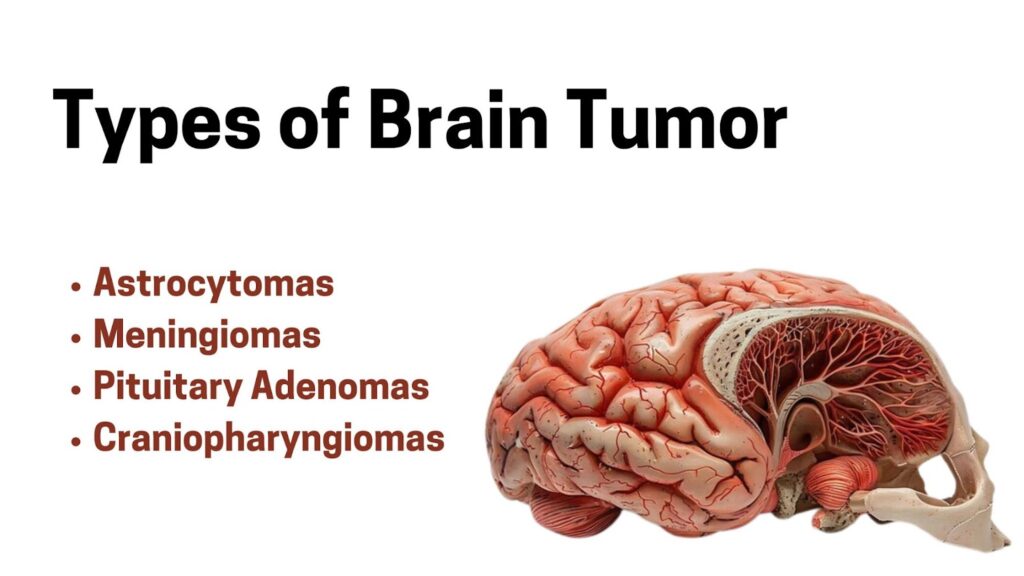If you’re searching for information on types of brain tumors, you’re likely seeking clarity about a complex and often overwhelming topic. Brain tumors, whether benign or malignant, can profoundly impact health and quality of life, making it essential to understand their differences. In 2025, advancements in neuroimaging and molecular diagnostics have significantly deepened our understanding, enabling patients and their families to navigate this challenging condition more effectively. This comprehensive guide explores the main types of brain tumors, compares benign versus malignant tumors, and highlights key characteristics to empower you with knowledge. From meningiomas to glioblastomas, we’ll break down what you need to know about brain tumors today.
What Is a Brain Tumor?
A brain tumor is an abnormal growth of cells in or around the brain, which can disrupt normal brain function. Tumors may originate in the brain (primary tumors) or spread from other parts of the body (secondary or metastatic tumors). They vary in size, location, and behavior, influencing symptoms like headaches, seizures, or cognitive changes.
Key Facts About Brain Tumors in 2025
- Prevalence: Approximately 80,000–100,000 new primary brain tumor cases are diagnosed annually worldwide, with 20,000–30,000 in India.
- Types: Over 120 distinct brain tumor types, classified by cell origin and behavior.
- Advancements: AI-driven diagnostics and genetic profiling improve tumor identification, enhancing patient outcomes.
- Impact: Symptoms depend on tumor location, size, and growth rate, affecting areas like vision, movement, or memory.
Understanding whether a tumor is benign or malignant is crucial for determining its potential impact and urgency.

Benign vs. Malignant Brain Tumors: What’s the Difference?
Brain tumors are broadly categorized as benign (non-cancerous) or malignant (cancerous), based on their growth behavior and potential to spread. Below, we compare their key characteristics.
| Feature | Benign Brain Tumors | Malignant Brain Tumors |
|---|---|---|
| Growth Rate | Slow-growing, less aggressive | Fast-growing, highly aggressive |
| Spread | Rarely spread beyond original site | May invade nearby tissues or metastasize |
| Borders | Well-defined, easier to remove surgically | Irregular, infiltrative, harder to remove |
| Symptoms | May be asymptomatic or cause pressure-related issues | Severe symptoms due to rapid growth and invasion |
| Prognosis | Generally better, but depends on location | Poorer, varies by type and stage |
| Examples | Meningioma, pituitary adenoma | Glioblastoma, medulloblastoma |
Benign Brain Tumors
- Definition: Non-cancerous tumors that grow slowly and typically don’t spread.
- Challenges: Can still be dangerous if they press on critical brain structures (e.g., optic nerves, brainstem).
- Prevalence: Account for 50–60% of primary brain tumors, per 2025 data.
- Symptoms: Headaches, seizures, or focal neurological deficits, depending on location.
Malignant Brain Tumors
- Definition: Cancerous tumors that grow rapidly and may invade surrounding tissues or metastasize.
- Challenges: Difficult to treat due to infiltrative nature and resistance to therapies.
- Prevalence: Represent 40–50% of primary brain tumors, with higher mortality rates.
- Symptoms: Severe headaches, cognitive decline, motor deficits, or seizures.
Common Types of Benign Brain Tumors
Benign brain tumors are often treatable with surgery or observation, but their location can complicate outcomes. Below are the most common types in 2025.
1. Meningioma
- Description: Originates in the meninges (membranes surrounding the brain and spinal cord).
- Prevalence: Accounts for 30–40% of primary brain tumors, more common in women aged 50–70.
- Characteristics: Slow-growing, often benign (90% are non-cancerous), but atypical or malignant variants exist.
- Symptoms: Headaches, vision changes, seizures, or limb weakness, depending on location.
- 2025 Insights: Molecular markers (e.g., NF2 mutations) guide personalized management.
2. Pituitary Adenoma
- Description: Develops in the pituitary gland, which regulates hormones.
- Prevalence: 10–15% of primary brain tumors, affecting adults aged 30–50.
- Characteristics: Mostly benign, categorized as functioning (hormone-secreting) or non-functioning.
- Symptoms: Hormonal imbalances (e.g., weight gain, infertility), vision loss, or headaches.
- 2025 Insights: Endoscopic surgery and targeted therapies improve outcomes for complex cases.
3. Acoustic Neuroma (Vestibular Schwannoma)
- Description: Grows on the vestibular nerve, affecting balance and hearing.
- Prevalence: 5–8% of primary brain tumors, typically in adults aged 40–60.
- Characteristics: Slow-growing, benign, linked to neurofibromatosis type 2 in rare cases.
- Symptoms: Hearing loss, tinnitus, dizziness, or facial numbness.
- 2025 Insights: Stereotactic radiosurgery (e.g., Gamma Knife) offers non-invasive management.
4. Craniopharyngioma
- Description: Arises near the pituitary gland, often in children or older adults.
- Prevalence: Rare, 2–5% of primary brain tumors, bimodal age distribution (5–14 and 50–70).
- Characteristics: Benign but locally aggressive, causing pressure on nearby structures.
- Symptoms: Vision loss, hormonal deficiencies, or growth delays in children.
- 2025 Insights: Proton therapy minimizes damage to surrounding tissues.
Common Types of Malignant Brain Tumors
Malignant brain tumors are aggressive and require prompt intervention. Below are the most prevalent types in 2025.
1. Glioma
- Description: Originates in glial cells (supportive brain cells), including astrocytomas, oligodendrogliomas, and ependymomas.
- Prevalence: 30–35% of primary brain tumors, affecting adults and children.
- Characteristics: Grades I–IV, with higher grades (e.g., glioblastoma) being more aggressive.
- Symptoms: Seizures, headaches, cognitive decline, or motor deficits.
- 2025 Insights: IDH mutation testing and immunotherapy trials improve prognosis for low-grade gliomas.
2. Glioblastoma (Grade IV Glioma)
- Description: The most aggressive primary brain tumor, arising from astrocytes.
- Prevalence: 15–20% of primary brain tumors, common in adults aged 50–70.
- Characteristics: Rapidly invasive, poorly defined borders, high recurrence rate.
- Symptoms: Severe headaches, personality changes, seizures, or neurological deficits.
- 2025 Insights: Tumor-treating fields (TTFields) and AI-guided radiotherapy extend survival.
3. Medulloblastoma
- Description: A cancerous tumor in the cerebellum, primarily affecting children.
- Prevalence: 15–20% of pediatric brain tumors, rare in adults.
- Characteristics: Fast-growing, often spreads through cerebrospinal fluid.
- Symptoms: Balance problems, headaches, vomiting, or coordination issues.
- 2025 Insights: Molecular subtyping (e.g., SHH, WNT) guides targeted therapies.
4. Metastatic Brain Tumors
- Description: Secondary tumors that spread to the brain from cancers elsewhere (e.g., lung, breast).
- Prevalence: 20–40% of all brain tumors, more common than primary tumors.
- Characteristics: Multiple lesions, aggressive, linked to primary cancer stage.
- Symptoms: Headaches, seizures, cognitive changes, or focal deficits.
- 2025 Insights: Liquid biopsies detect metastatic origins, aiding treatment planning.
Primary vs. Secondary Brain Tumors
Understanding the origin of a brain tumor is key to its classification:
- Primary Brain Tumors: Originate in the brain or nearby tissues (e.g., meninges). Examples include meningiomas and gliomas.
- Prevalence: 60–80% of brain tumors, per 2025 data.
- Behavior: Can be benign or malignant.
- Secondary Brain Tumors: Metastasize from other cancers (e.g., melanoma, kidney).
- Prevalence: More common than primary tumors, especially in adults.
- Behavior: Always malignant, often multiple.
How Are Brain Tumors Classified in 2025?
In 2025, brain tumors are classified using the World Health Organization (WHO) system, updated to incorporate molecular and genetic markers:
- Cell Origin: E.g., glial cells (gliomas), meninges (meningiomas).
- Grade: I (benign, slow-growing) to IV (malignant, aggressive).
- Molecular Profile: Mutations like IDH, 1p/19q co-deletion, or MGMT methylation guide prognosis and therapy.
- Location: E.g., frontal lobe, cerebellum, brainstem.
This precision enhances diagnostic accuracy, with AI tools analyzing genetic data to refine classifications.
Symptoms of Brain Tumors by Type
Symptoms vary by tumor type and location:
- Meningioma: Headaches, seizures, vision or hearing changes.
- Glioblastoma: Rapid-onset headaches, cognitive decline, motor weakness.
- Pituitary Adenoma: Hormonal issues (e.g., fatigue, infertility), vision loss.
- Medulloblastoma: Balance issues, vomiting, coordination problems.
- Metastatic Tumors: Multiple symptoms, depending on lesion sites.
For a detailed symptom overview, see our brain tumor symptoms guide.
Why Understanding Tumor Types Matters
Knowing whether a brain tumor is benign or malignant, primary or secondary, informs critical decisions:
- Urgency: Malignant tumors like glioblastomas require immediate action, while benign meningiomas may be monitored.
- Prognosis: Benign tumors often have better outcomes, but location matters (e.g., brainstem tumors are riskier).
- Planning: Molecular classification in 2025 guides personalized approaches, improving survival rates.
- Empowerment: Understanding tumor types helps patients and families advocate for their care.
What to Do If You Suspect a Brain Tumor
If you or a loved one experience symptoms like persistent headaches, seizures, or neurological changes:
- Track Symptoms: Note frequency, severity, and triggers in a diary.
- Consult a Neurologist: Use platforms like Practo or Apollo 24|7 for specialist referrals.
- Seek Diagnostic Tests: MRI, CT, or biopsy may be recommended.
- Stay Informed: Learn about your tumor type to discuss options confidently.
FAQs About Brain Tumor Types
Q: What’s the most common type of brain tumor?
A: Meningiomas are the most common, accounting for 30–40% of primary brain tumors, mostly benign.
Q: Are all brain tumors cancerous?
A: No, benign tumors like meningiomas are non-cancerous, while malignant tumors like glioblastomas are cancerous.
Q: Can benign brain tumors become malignant?
A: Rarely, some benign tumors (e.g., atypical meningiomas) may progress to malignancy.
Q: What’s the difference between a glioma and a meningioma?
A: Gliomas arise from glial cells and are often malignant; meningiomas originate in the meninges and are usually benign.
Q: How are brain tumors detected in 2025?
A: Advanced MRI, AI-driven imaging, and genetic profiling ensure precise detection.
Take the Next Step
Understanding the types of brain tumors—benign vs. malignant, primary vs. secondary—empowers you to take charge of your health. Whether it’s a slow-growing meningioma or an aggressive glioblastoma, knowledge is your ally. In 2025, cutting-edge diagnostics offer hope for better outcomes. If you’re experiencing symptoms or seeking clarity, consult a neurologist today to explore your options.
Call to Action: Worried about brain tumor symptoms? Share your questions in the comments or book a consultation to start your journey toward answers!
